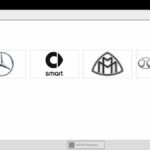The coolant warning light on your BMW dashboard is designed to alert you to low coolant levels, a crucial factor in preventing engine overheating. However, an intermittent warning light can be frustrating and concerning. This article will guide you through understanding the BMW coolant system, particularly focusing on the coolant level switch and common causes of an intermittent warning light.
Understanding the BMW Coolant System and the Coolant Level Switch
Unlike some vehicles that use a coolant sensor to measure the temperature and level of the coolant, BMWs typically employ a coolant level switch located in the coolant reservoir. This switch acts as a simple on/off mechanism. When the coolant level drops below a certain point, the switch closes, grounding a specific pin on the Junction Box Electronics (JBE) module. This ground signal triggers the coolant warning light on the instrument cluster.
It’s important to distinguish between a coolant level sensor and a switch. A sensor provides continuous data about the coolant level, while a switch simply indicates whether the level is above or below a threshold. In a BMW, the simpler switch mechanism is often sufficient to provide a timely warning.
Common Causes of an Intermittent BMW Coolant Warning Light
If your BMW’s coolant level is confirmed to be adequate, yet the warning light flickers intermittently, the problem likely lies within the switch itself or the wiring connected to it. Here are some potential culprits:
-
Faulty Coolant Level Switch: The switch itself may be malfunctioning, intermittently connecting the ground wire even when the coolant level is normal. Over time, the switch can wear out or become corroded, leading to erratic behavior.
-
Wiring Issues: A more common problem is a wiring fault in the brown/white wire that runs between the coolant level switch connector (X112) and the JBE module. This wire can become damaged, chafed, or corroded, causing intermittent grounding and triggering the warning light. The connector itself can also be a source of problems. Corrosion or a loose connection can lead to intermittent signal disruptions.
-
Grounding Issues: A less likely but still possible cause is a problem with the ground connection at the switch or elsewhere in the circuit. A poor ground can cause voltage fluctuations and trigger the warning light erratically.
Diagnosing the Problem
Diagnosing an intermittent coolant warning light requires a systematic approach:
-
Visual Inspection: Begin by visually inspecting the coolant reservoir, the switch, and the wiring harness for any obvious signs of damage, corrosion, or loose connections. Pay particular attention to the connector X112.
-
Wiring Test: With the ignition on, disconnect connector X112 and observe the warning light. Gently manipulate the wiring harness and see if the light comes on. You can also bridge the connector terminals with a test wire to see if that triggers the light. These tests can help pinpoint a wiring issue. Refer to the BMW TIS (Technical Information System) for detailed wiring diagrams and connector locations.
-
Switch Testing: If wiring tests don’t reveal the problem, the coolant level switch itself may need to be tested. This often involves removing the switch and checking its continuity with a multimeter.
Resolving the Issue
Once the problem is diagnosed, the solution is usually straightforward:
-
Replace the Coolant Level Switch: If the switch is faulty, replacement is the most effective solution.
-
Repair or Replace Wiring: Damaged or corroded wiring needs to be repaired or replaced. Ensure all connections are clean and secure.
-
Address Grounding Problems: If a grounding issue is identified, clean the ground connection points and ensure a solid connection.
Conclusion
An intermittent coolant warning light in your BMW can be a symptom of a simple issue like a faulty switch or wiring problem. By understanding the function of the coolant level switch and following a systematic diagnostic approach, you can effectively identify and resolve the problem, ensuring the continued health of your BMW’s engine. If you’re not comfortable working on your car’s electrical system, it’s always best to consult a qualified BMW technician.

